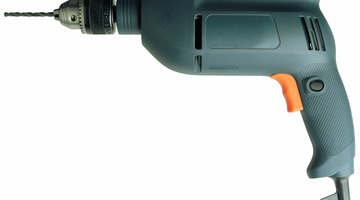How to Repair a Wood Table Leg
Over the course of a wooden table’s life, a problem that many table owners have is that their wooden furniture can become worn or even break along the legs. A worn table leg may be shorter than the other legs, while a broken leg may have a crack, a splintering or a full separation of the parts of the leg.

Repairing a table leg does not require intimidating woodworking tools that include lathes or carving knives. A novice can fix a table leg with no prior woodworking experience.
Uneven legs
-
Turn your table over so that the legs point up.
-
Measure your table legs to determine the height of each leg. The difference in height of the legs is the reason for the table's unevenness.
-
Drill a hole into the center bottom of the uneven leg that is slightly smaller in length than the leg-leveler screw, but the same diameter.
-
Insert the screw into the drill hole so that the leg is as long as the other three legs, and tighten into place.
Broken legs
-
Turn the table over so that the legs point up.
-
Clean the surfaces of the break with furniture cleaner that contains mineral spirits. Such cleaners are designed for cleaning wood and are suitable for woodworking projects.
-
Apply wood glue to both surfaces of the break. Wood glue is formulated to dry into a stronger bond than the wood itself.
-
Press the surfaces of the break together and hold them in place with a woodworking clamp. Be careful to not let the clamp touch the drying glue, so that you do not accidentally glue the clamp to your table leg.
-
Fill in gaps in splintered wood with wood epoxy and a putty knife.
-
Allow wood glue and wood epoxy to dry up to 48 hours before releasing the wood clamps, turning the table back over and using it.
Things You Will Need
- Measuring tape
- Leg leveler screw
- Drill
- Assorted drill bits
- Furniture cleaner
- Cleaning rag
- Wood glue
- Woodworking clamps
- Slow set wood epoxy
- Putty knife
Tip
Before beginning your project, you may wish to put down a tarp to protect your work surface against glue drips. Eye protection should be worn when operating power tools. You should work in a well-ventilated room when working with glue or epoxy
References
Writer Bio
Tracy Morris has been a freelance writer since 2000. She has published novels and numerous online articles. Her work has appeared in national magazines and newspapers including "Ferrets," "CatFancy," "Lexington Herald Leader" and "The Tulsa World." She holds a Bachelor of Arts in journalism from the University of Arkansas.
Photo Credits
- Stockbyte/Stockbyte/Getty Images
- Stockbyte/Stockbyte/Getty Images
More Articles



